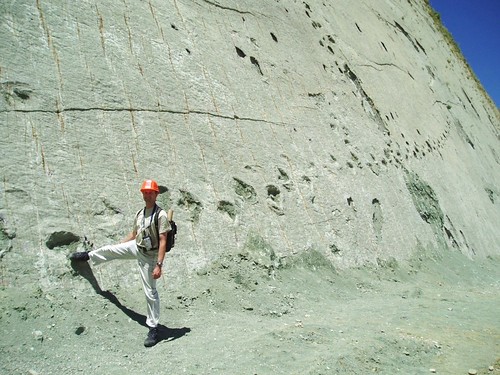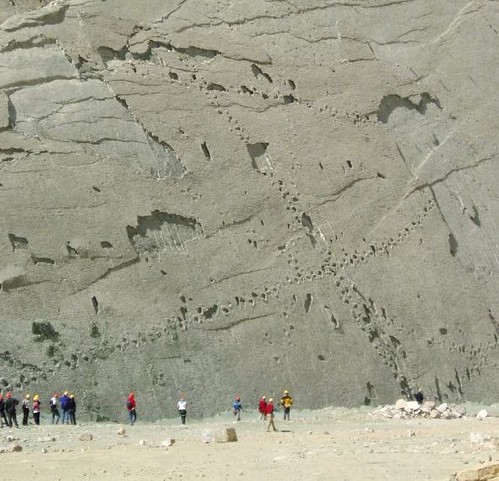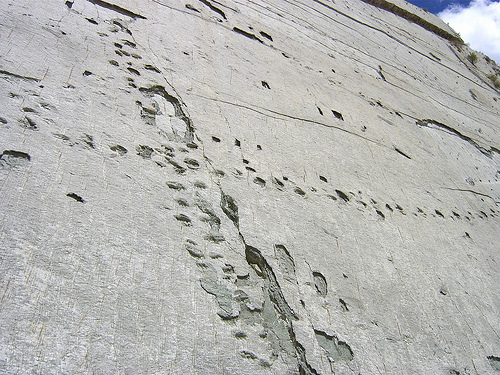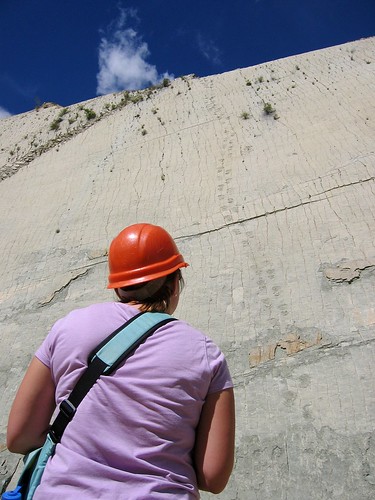 Image: Yatlik.com
Image: Yatlik.com
The immense Bolivian site is the rock face of an outcropping on a slant of 73 degrees, 80 meters high and 1.2 km long. There are more than 5,000 tracks of 294 different dinosaurs made during the second half of the Cretaceous period.
There is such an impressive amount of tracks that some of the researchers said this place seemed to be a dinosaurs’ dancefloor. Image: Jpspbj (Flickr)
Image: Jpspbj (Flickr)
According to dinosaurus.org, the tracklevel dates from the Late Cretaceous and forms part of the El Molino Formation, the estimated age is about 68 million years. More than 250 trackways have been registered and six different types of dinosaurs have been present. The most spectacular trackways are those of quadrupedal titanosaurs, herbivore animals with a size between 15 and 25m. Image: Rikkiandmatt (Flickr)
Image: Rikkiandmatt (Flickr)
Perhaps, the most special track is a 347 meters footpath, the longest dinosaur trackway ever known, made by a baby Tyrannosaurus rex nicknamed “Johnny Wallker” by researchers. Image: Ryan Greenberg (Flickr)
Image: Ryan Greenberg (Flickr)
During the Cretaceous, Cal Orko was part of an immense shallow lake. In the Tertiary, when the Andes Mountains were formed, the movement of the tectonic plates pushed the former lake bed vertically. Not far from this site, eight others have been found in recent years and are currently being studied. Image: Ramón Arellano (Flickr)
Image: Ramón Arellano (Flickr)
According to Christian Meyer, the discovery is an enormous contribution to humanity and to science, revealing data heretofore unknown and "documenting the high diversity of dinosaurs better than any other site in the world".
To contribute to preserving the site, a Cretaceous Park is open since March 2006. In this park, replicas of different dinosaur species welcome visitors to a museum with audiovisual exhibits, transporting their minds to prehistoric time. Image: Flyingtiti (Picasa)
Image: Flyingtiti (Picasa)
More info: 1, 2, 3
References: Las huellas de Cal Orcko (duiops.net) / Los saurios de Sucre (Artículo de la revista BDW, sept 2001) / Parque Cretácico (web oficial) / Cal Orko (Wikipedia)
Imagine a wall with more than 5,000 dinosaur tracks. They call it the dinosaurs dancefloor
26 septiembre 2008
In 1994, while walking around a cement factory in southern Bolivia, Klaus Schütt discovered a limestone wall with a shear size of 25'000 square meters literally covered by dinosaur tracks. A few years later, in 1998, a scientific team lead by Swiss paleontologist Christian Meyer investigated the wall, and proved it was "the largest site of dinosaur tracks found so far".
Escrito por Aberrón a las 12:03 | 3 comentarios »















